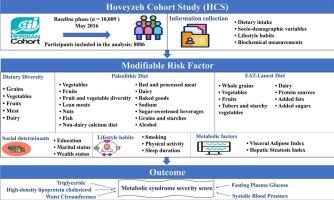Untangling the role of diet quality and other risk factors in the severity of metabolic syndrome: Insights from the Hoveyzeh Cohort study using structural equation modeling
IF 7.4
3区 医学
Q1 ENDOCRINOLOGY & METABOLISM
引用次数: 0
Abstract
Aims
In this study, we aim to employ structural equation modeling (SEM) to assess the relationships between adherence to diet quality scores, such as the Dietary Diversity Score (DDS), Paleolithic Diet Score (PDS), and EAT-Lancet Diet Score, and other risk factors, including, demographic, socio-economic, behavioral, and clinical characteristics, with MetS severity.
Methods
This cross-sectional study involved 8,086 participants from the Hoveyzeh Cohort Study (3,486 males and 4,600 females). Dietary intake was assessed using a validated semi-quantitative food frequency questionnaire, which was also used to calculate energy-adjusted diet scores. Anthropometric, biochemical, and blood pressure measurements were evaluated following standardized protocols. The interrelationships between risk factors and MetS severity were analyzed using SEM.
Results
The models indicated that the DDS had a statistically significant association with MetS severity through direct effects (βFemales = -0.04; βMales = -0.04) and indirect effects (βFemales = -0.06; βMales = -0.09). Similarly, the PDS showed a statistically significant inverse relationship with MetS severity, including direct effects (βFemales = -0.03; βMales = -0.02) and indirect effects (βFemales = -0.05; βMales = -0.07). In contrast, the EAT-Lancet Diet Score demonstrated a statistically significant inverse association with MetS severity only through indirect effects (βFemales = -0.04; βMales = -0.03).
Conclusion
The findings emphasize that improving diet quality as a means of managing modifiable risk factors may reduce MetS severity.

解开饮食质量和其他危险因素在代谢综合征严重程度中的作用:使用结构方程模型的Hoveyzeh队列研究的见解
目的在本研究中,我们旨在采用结构方程模型(SEM)来评估饮食质量评分(如饮食多样性评分(DDS)、旧石器时代饮食评分(PDS)和EAT-Lancet饮食评分)与其他风险因素(包括人口统计学、社会经济、行为和临床特征)与MetS严重程度之间的关系。方法本横断面研究涉及来自Hoveyzeh队列研究的8086名参与者(3486名男性和4600名女性)。膳食摄入量的评估使用经过验证的半定量食物频率问卷,该问卷也用于计算能量调整饮食得分。人体测量、生化和血压测量按照标准化方案进行评估。使用扫描电镜分析危险因素与MetS严重程度之间的相互关系。结果模型显示,DDS通过直接效应(β female = -0.04; β male = -0.04)和间接效应(β female = -0.06; β male = -0.09)与MetS的严重程度有统计学意义。同样,PDS与MetS严重程度呈显著负相关,包括直接效应(β female = -0.03; β male = -0.02)和间接效应(β female = -0.05; β male = -0.07)。相比之下,EAT-Lancet饮食评分仅通过间接影响(β女性= -0.04;β男性= -0.03)显示与MetS严重程度有统计学意义的负相关。结论:研究结果强调,改善饮食质量作为一种管理可改变危险因素的手段可能会降低MetS的严重程度。
本文章由计算机程序翻译,如有差异,请以英文原文为准。
求助全文
约1分钟内获得全文
求助全文
来源期刊

Diabetes research and clinical practice
医学-内分泌学与代谢
CiteScore
10.30
自引率
3.90%
发文量
862
审稿时长
32 days
期刊介绍:
Diabetes Research and Clinical Practice is an international journal for health-care providers and clinically oriented researchers that publishes high-quality original research articles and expert reviews in diabetes and related areas. The role of the journal is to provide a venue for dissemination of knowledge and discussion of topics related to diabetes clinical research and patient care. Topics of focus include translational science, genetics, immunology, nutrition, psychosocial research, epidemiology, prevention, socio-economic research, complications, new treatments, technologies and therapy.
 求助内容:
求助内容: 应助结果提醒方式:
应助结果提醒方式:


